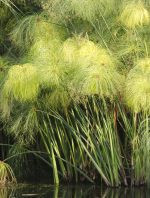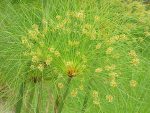
Also known as paper reed and Nile grass, this tender aquatic herbaceous perennial is native to lakes, rivers and swamps of northern Africa, and was cultivated in the Nile Delta in ancient times. It is a member of the sedge family, Cyperaceae, that also includes water chestnut and nutgrass, a common lawn weed. The plants are up to 16′ tall and form grass-like clumps. They have thick woody rhizomes that are covered by red-brown triangular scales when young. Triangular green stems support dense umbels up to 12″ across of thin bright green thread-like structures up to 10″ long. Greenish-brown flower clusters appear at the ends of the threads and give way to brown, nut-like fruits. Papyrus has a long history of use going back to the ancient Egyptians who made one of the first kinds of paper with the stems. Parts of the plant are edible and the stems are very buoyant so can be made into boats. Papyrus is used as a house plant, and as an ornmental in water gardens of frost free areas such as Florida where it has become invasive. The genus name, Cyperus, is from the Greek word kypeiros , the name given to sedges in ancient times. The specific epithet, papyrus, comes from the Greek word πάπυρος, referring to paper made into rolls.
 Type: Aquatic tender herbaceous perennial
Type: Aquatic tender herbaceous perennial
Bloom: Small greenish brown clusters at the tip of thread-like styructures
Size: 5-16′ x 2-4′ W
Light: Full sun to partial shade
Soil: Wet, boggy, shallow standing water
Hardiness: Zones 9-11
Care: Contain growth if necessary
Pests and Diseases: None of significance
Propagation: Division
Companion Plants: Lousiana iris, spiderlily, pickerelweed
Outstanding Selection: C. p. ‘Nanus’ (dwarf, 2-3′ tall)
Photo Credits: Wikipedia